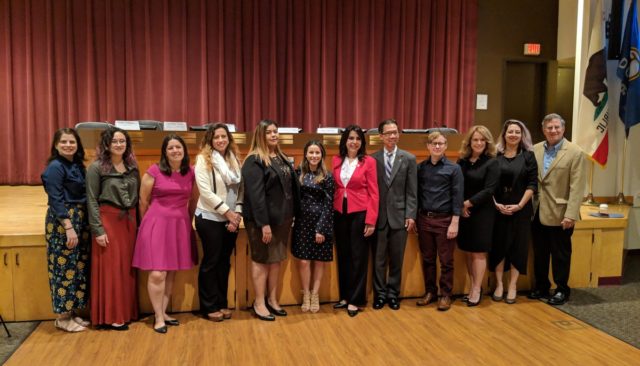NNEDV Testimony for the California State Assembly
October 29, 2018
The Testimony of Corbin Streett, MSW,
Technology Safety Specialist, Safety Net
National Network to End Domestic Violence
Before the Joint Assembly Select Committees on Domestic Violence and Privacy and Consumer Protection
California State Assembly
on
October 26, 2018
Chairpersons Rubio and Chow, distinguished members of the Committees – my name is Corbin Streett, and I work as a Technology Safety Specialist at the Safety Net Project at the National Network to End Domestic Violence. At Safety Net, we address the intersection of technology and abuse, providing training and technical assistance to survivors, victim advocates, state domestic violence and sexual assault coalitions, law enforcement, court personnel, attorneys, government agencies and technology companies. On behalf of Safety Net’s founder, Cindy Southworth, and our Director, Erica Olsen, I’d like to thank you for the opportunity to appear before you today to address the Joint Assembly Select Committees’ concerns related to the intersection of domestic violence and technology. Our members from across the nation, including the California Partnership to End Domestic Violence who invited us here today, and the local California victim assistance programs they work on behalf of, are extremely concerned about the impact of technology misuse on victims of domestic violence. To give a number to the enormity of the problem – a 2014 survey we conducted of local victim service programs found that 97% of advocates surveyed reported that abusers were misusing technology to stalk, harass and control victims. It speaks highly of your state, that you are carefully considering this complex issue, and contemplating policy development to help enhance protections and decrease victimization.
Today I want to open with a story. And I ask that you keep in mind that while it’s just one story, it offers a glimpse at the toll technology misuse has on the physical, emotional and economic wellbeing of countless survivors. A few weeks ago, a victim reached out to our team, and I took the call. Over the course of a few years, this person had gone back to school, gotten a degree while working a full-time job and parenting 2 small children. She’d just been hired into a new position at a small firm in her field. Her start date was set for 3 weeks out. With two weeks left, she got a call from the owners of the company. They’d run a second post-hire search of her name on Google, something standard in their hiring practices, and had discovered numerous social media posts with her name, photograph, and very lewd accusations. The posts had been made on the personal page of someone she had briefly dated. She didn’t know about the posts until the employer called. Because the position she’d been hired to fill was a public-facing position, they told her they had to put her hiring on hold and would not be able to bring her on if the posts didn’t come down. She contacted the technology companies and flagged the posts to be taken down. Unfortunately, they were carefully crafted in a way that they did not violate the Terms of Services of the social networks. But they were lewd enough for the company to reconsider their offer. The technology companies responded to her reports, saying the posts didn’t violate their terms. On her behalf, we reached out to our contacts at the companies and asked them to reconsider, noting the impact on her employment. The posts came down, but the abusive person posted more lewd content on other sites. For over two weeks, we played this game of whack-a-mole: the abuser would post something, she’d find it and report it, we’d reach out to the company requesting that the posts be removed, explaining the harm they were causing. Unfortunately, the abuse tactics he used ended in the worst way – the company ultimately withdrew her job offer.
Survivors’ experiences of tech abuse is often minimized – people tell them that online harassment or constant repeated threatening texts isn’t really abuse. There is a perception that harassment and threats that occur in an online or mobile space don’t have a tangible, real-world impact. But as this story demonstrates – it not only has an impact, it can have devastating consequences, leaving the economic, emotional and physical wellbeing of victims and their children caught in the crosshairs of an abusive person who savvily posts content that is harassing and harmful, yet doesn’t escalate to the level of prohibitive content, as defined by a technology company’s terms of service.
Although this specific example focused on online posts, abusers misuse technology in a number of ways that have significant impact on victims. Abusers share intimate images of victims with their family or employers, forcing victims to have to explain those images while feeling humiliated. Physical assaults, sexual assaults and rapes of victims are recorded and live streamed, furthering potential harm and abuse by others. Abusers monitor and stalk victims through a wide range of technology, including spyware software installed on the victim’s devices that can be used to monitor their every interaction. They manipulate home automation tools, such as turning lights and radios and televisions on and off remotely. Survivors tell us they feel haunted, that they don’t have any control over their lives. They tell us that when they try to get help, people just think they’re crazy because what is happening doesn’t seem possible. In some cases, victims literally cannot escape, because even after the victim has left and relocated abusers use publicly available information to track them down and continue to stalk them.
On the other side of the spectrum, we hear from others who do acknowledge that technology misuse and online abuse is truly abuse, but blame the technology and the tech companies for the harm caused. Or blame the victims for being online or staying online. This, again, is misplaced blame. It’s not the technology that harms the victims. The misuse of technology is what causes the harm. The onus and responsibility should be directed to the person who chose to cause harm.
The solution simply cannot be for survivors to disengage from technology. Survivors have a right to use technology, to participate in life both online and off, and live free from harassment, abuse and stalking. Abusers have often systematically stripped away community and familial connection, financial resources, and a safe home. Smartphones, email, social media, and access to the Internet are often the last remnants of a survivor’s connection to support, and can serve as an important lifeline when they’re in danger or working to rebuild their life. Technology is a necessity in our everyday lives. Telling someone who is being terrorized by an abusive person that the way to stop the abuse is for them to stop using a device or to get off of a platform is not an acceptable solution. Limiting a victim’s access to technology will not stop the abuse they are experiencing. Technology facilitated abuse is an extension of real-world abuse. It’s another tool abusers use to harass, threaten, stalk and harm. Just as we would consider it preposterous to tell a survivor who’s being harassed at work to quit their job, or to tell a survivor who’s being followed while they drive in their car to get rid of their car, so should we consider it preposterous to tell them to get rid of their technology or go offline when it is someone else who is perpetuating the harmful behavior. Such advice only empowers the abusive partner by disconnecting the survivor and cutting off access to vital tools.
Technology companies do have a role to play – in the solution. We advise a wide range of technology companies, including Facebook, Twitter, and Snapchat. When they are developing new features, products, and policies, we review them and provide feedback on how abusers can misuse them to harm their victims, and the impact such misuse could have on survivors. Technology companies have come a long way. Many now have internal teams and external advisory boards committed to developing products that are less likely to be misused. We often hear and use the term privacy by design. It’s time that we also invest in safety by design. We recognize that this is a very complex issue. It’s our hope that companies invest more in harm prevention and user privacy as they develop tools, holding safety as paramount, and integrating accountability mechanisms that work to empower victims and stifle abusive behavior.
We cannot underestimate the potential harm to victims caused by the misuse of technology. It is imperative that we continue to work together – policy makers, technology companies, the victim service community, and survivors of abuse – to find solutions that result in safer communities – both online and off. We applaud the California State Assembly for considering the impact of technology misuse on victims, and for working to develop thoughtful approaches. Thank you for allowing me the opportunity to address the Joint Committees on this critical and urgent issue. I am happy to answer any questions.





